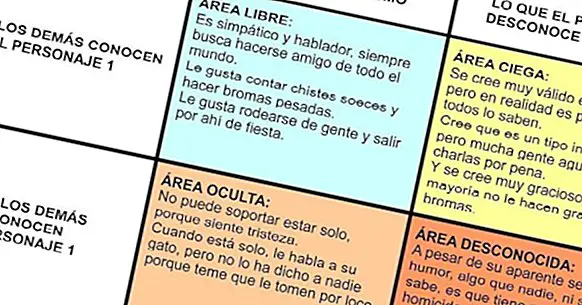The 4 styles of relationships, according to the Johari Window
A difficulty in interpersonal relationships are the different impressions that each makes of the other. So much so that, Many times they lead to conflict, because they can treat us in a different way than we feel . However, others can be a facility, since we can discover, thanks to the other, parts that we did not know about our personality and character.
Types of relationships according to the Johari Window
A simple and simple explanatory model of how the parts that are known and unaware of oneself are measured is the Johari window , proposed by Joseph Luft and Harry Ingham. In it, the "I", the person itself, is distinguished on a horizontal axis; while on the vertical axis "the other" or "the others".
This is how they form 4 quadrants that distinguish four areas of self-knowledge in their relationships :
- Free area : is the quadrant of that known by oneself and by others . This quadrant includes everything that is communicated verbally and that becomes a mutual knowledge of people. It indicates the degree to which we make ourselves known to the world, we open ourselves and let us know about our experiences, thoughts, intentions and emotions.
- Hidden area : the hidden area it comes from what is known by oneself, but not by others. This includes all the information that the person keeps for himself and does not expose; he hides it from the eyes of the rest. In this quadrant are included those features that the personality that one is most reluctant to show or that is saved for itself.
- Blind area : in this quadrant stand out those traits that we do not know about ourselves , but you know the others . Once or twice we have been amazed and discovered parts of how we are thanks to what others have told us. This is when the blind area comes up; that by not being able to control everything we do, there is always something that of us that hides in it and that only from outside we can discover.
- Unknown area : in the unknown area it includes everything that we do not know about ourselves and that also does not know the rest . It may well be seen as the zone that both sides overlook; however at the same time it may be the area of growth and potential. Here is the ability to learn and grow, to learn new things about oneself and to discover them.

Explaining the picture
These four quadrants are dynamic, so that increase and decrease according to our life time, type of relationship we are in or the environment where we are . But at the same time they are dependent, that is, a change in one of the areas results in the others being mobilized. This is how by revealing part of how we are, we are reducing the hidden area and increasing the free area. This fact also implies that there are different ways to reach the same end, for example, the free area also expands as the other lets us know how he sees us, reducing the blind area.
The 16 different types of interpersonal relationships
Likewise, this model focuses on relationships with other people, in which the knowledge of oneself is not only achieved through introspection, but also through information from the outside. In the same way, also when relating to us, the other has his own model of his Johari window. Thus, you can give a total of 16 different types of relationships . In order not to extend, only some of them will be affected.
Free area relations
In both people the free area predominates. In this way, the relationship is characterized by a clear and precise communication, since there are no hidden sides and you have the necessary knowledge to be understood and understood. These are relationships in which empathy and acceptance are favored, allow us to understand the congruence that regulates how the other person does, thinks and feels . They are people between whom communication flows and are sincere reciprocally. The key word of free area relations is understanding.
The other person becomes a companion, someone who understands your needs, and you understand theirs; a person who knows what looks and gestures mean and that, despite the differences, knowing them makes you tune. However, as a negative part, there are no reservations and one can feel vulnerable. With a large free area, beware of anger and anger, which sometimes work with impulsiveness and if the free zone is large, you know well where to hurt. In the same way, the mystery is lost against clarity; By making everything so clear there are not many questions to ask of each other and the interaction may be annoying.Well, with such understanding it is well known how to ask for forgiveness; or how to provide spontaneity, but the question in these cases is: does there really exist intention?
Hidden area relations
In this case, the largest quadrant is that of the hidden area, therefore, the other is almost unknown. They are relationships that prioritize safety, keep safe and move forward little by little so as not to be damaged . They could be characterized as relations of great respect towards intimacy, while maintaining the hidden area itself means paying special attention to the limits and frontiers in which one's own and others begin. Therefore, the focus of the relationship is how to receive, and the key word for this type of relationship would be care.
However, they are relationships with fear as the main emotion, in which the fear of being hurt or judgments may predominate. That can make it difficult to take steps and move slowly for all the way to go. There is also fear of the conflict, so that it is likely that you tend to keep things quiet, until one day it is exploited, of course. In the same way, if the tendency to hide is greater than to discover the other, communication can be tangential, not clear, so that people never get to meet each other.
Blind area relations
These are relationships in which people have a greater incidence in their blind area. Unlike the hidden area, every day is a discovery, but how is one as a person . They are relationships based on giving, characterized by being very sociable; we could say extroverted and impetuous. The main axis is communication, specifically in expressing how the other person is perceived; interpersonal explorers.
Therefore, they are a source of personal learning that promote greater self-knowledge, in which you see yourself in the eyes of the other. This is how your keyword is to grow. But attention, that sometimes do not grow for good. On the other hand, the appearance of prejudices is likely and in discussions the other person can be crossed out of what is not and, what is worse, to be created. Likewise, impetuosity derives more easily in conflicts, since we are not always satisfied with how they tell us we are; and focusing on giving can also be for the bad in those moments.
Blind-hidden area relations
They are stimulating relationships, since for the blind area explorer, you find a whole huge hidden area that you bring to light in the other person . It is a challenge to discover it and a mystery to know how the other person understands the world. Likewise, for the careful hidden one another challenge is added, keeping on keeping safe, not being discovered. They are relationships that motivate as a game: discover and hide. Seen as a game, they are characterized by having many ups and downs and surprise because they do not have a stable rhythm; today on the die, he plays a 1, tomorrow a 6, the next I return to the first box! Because of that, your keyword is intensity.
On the contrary, be careful that the expectations that are created may not be met and moreover, if you dig a lot into the other, rejection may occur. They are relationships that may have a tendency to toxicity due to dependence and dependence; one for obsessing about unraveling secrets and the other for the comfort of having a person constantly for him. Then there may be imbalances in the rhythm of each one of the relationship; while the blind man takes steps without looking, the blind watches each one. Also, their instability could turn them into fragile relationships, which easily both people can be harmed and hurt.
Some nuances and questions on the air
The relationships of strangers may be missing, but in those cases, how can we talk about relationships? After all, it is the beginning of all of them, to meet a person and not know what he is like, as well as to ignore how you will be when you relate to her. Because if the Johari Window is dynamic, so are all the typologies that derive from it. After being unknown, who knows if it will motivate us to know the other and we will be blind; or else we will have cracks of past experiences and we will prefer to remain hidden .
Who knows if after taking shelter we gain enough confidence and we will discover the other, let the light in and blind us. Who knows if in our exploration of the mysteries we are wounded and hide ourselves, we take shelter. But if you do not know the way well, if you know the end, a free area in which you simply are, in which it simply is, well as its name says, free.
Bibliographic references:
- Fritzen, J. (1987). The Johari window: group dynamics, human relations and awareness exercises. Editorial SAL TERRAE.



















